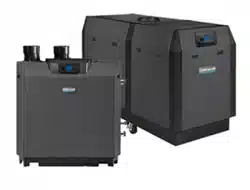Loading ...
Loading ...
Loading ...

13
SlimFit
®
Series 2
commercial condensing gas-fired water boiler
- User’s Information Manual
Part number 550-100-562/0321
Maintenance procedures — MONTHLY
Perform DAILY procedures plus the
following additional procedures . . .
Check vent piping
1. Visually inspect the ue gas vent piping for any signs of blockage,
leakage or deterioration of the piping. Notify your qualied service
technician at once if you nd any problem.
Failure to inspect the vent system as noted above and
have it repaired by a qualied service technician can
result in vent system failure, causing severe personal
injury or death.
Check air piping
(DIRECT VENT installations)
1. Visually inspect the air inlet to be sure it is unobstructed. Inspect
entire length of air piping to ensure piping is intact and all joints
are properly sealed.
2. Call your qualied service technician if you notice any problems.
Check the relief valve
1. Inspect the boiler relief valve and the relief valve discharge pipe
for signs of weeping or leakage.
2. If the relief valve oen weeps, the expansion tank may not be
working properly. Immediately contact your qualied service
technician to inspect the boiler and system.
Check the condensate drain system
1. While the boiler is running, check the discharge end of the
condensate drain tubing by holding your ngers in front of the
opening.
2. If you notice ue gas escaping, this indicates a dry condensate
drain trap. See step4 for procedure to ll trap. Call your qualied
service technician to inspect the boiler and condensate line and
rell the condensate trap if problem persists regularly.
Under some circumstances an SlimFit vent system
may not produce enough condensate to keep the
condensate trap full of liquid. If the trap is not full,
small amounts of ue products can be emied into the
boiler room through the condensate drain line. Follow
procedure below to ll trap.
3. Verify that the condensate drain line is unobstructed by slowly
pouring water into the inspection caps near the ue connection
(piping end of the boiler). e water should run out the end of
the condensate drain line. If the water does not run out, call your
qualied service technician to inspect the boiler and clean or
replace the condensate drain line.
1. Fill the condensate trap with fresh water, either by removing, ll-
ing and re-installing or by pouring water into the inspection caps
near the ue connection (piping end of boiler).
2. Remove the trap.
a. Loosen the two stainless steel hose clamps on the exible
coupling
b. Slide the exible coupling over the 1” PVC pipe connected
to the trap.
c. Loosen the condensate trap inlet connection.
d. Remove condensate trap and ush as needed.
e condensate trap must be lled with water during
all times of boiler operation to avoid ue gas emission
from the condensate drain line. Failure to ll the trap
could result in severe personal injury or death.
Check automatic air vents (if used)
1. See illustration at right.
2. Remove the cap from any automatic air
vent in the system and check operation
by depressing valve “B” slightly with the
tip of a screwdriver.
3. If the air vent valve appears to be working
freely and not leaking, replace cap “A”,
twisting all the way on.
4. Loosen cap “A” one turn to allow vent to
operate.
5. Have vent replaced if it does not operate
correctly.
Loading ...
Loading ...
Loading ...
